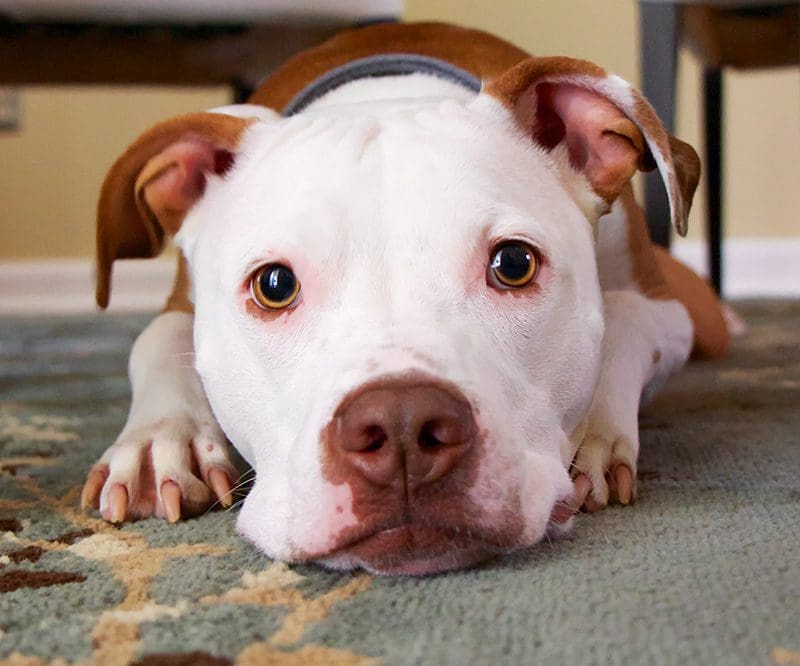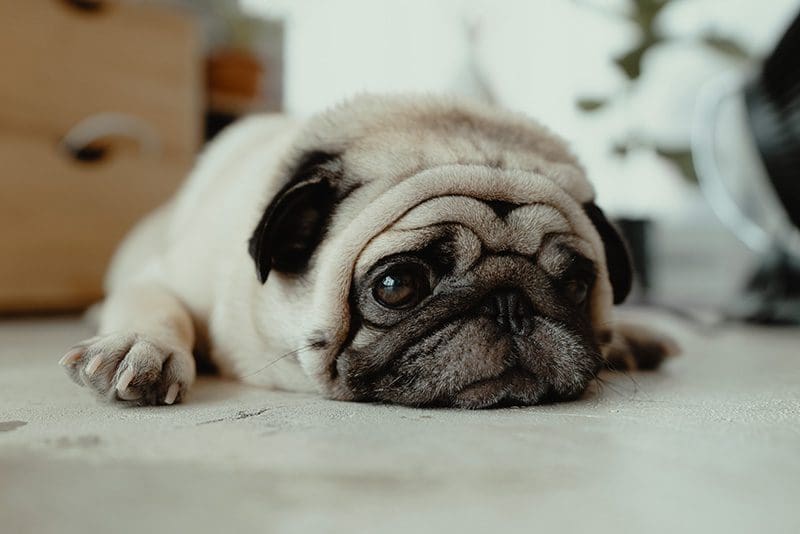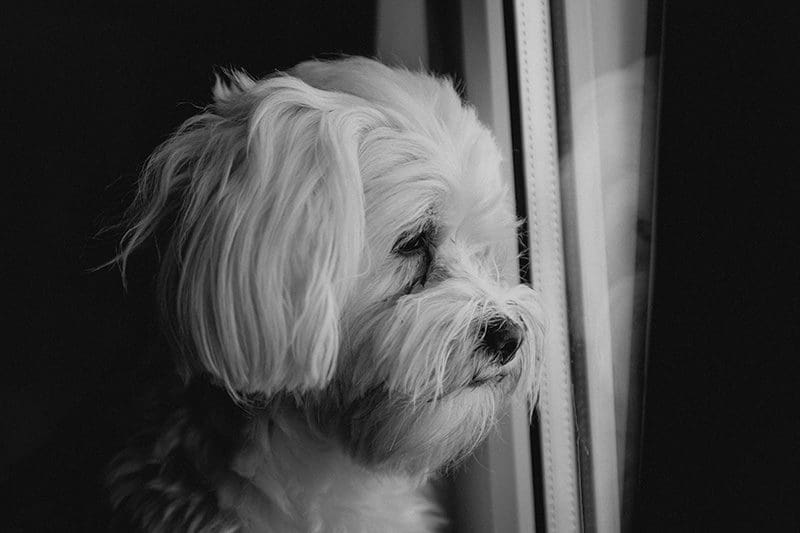
How to Get Dog Pee Out of Carpet
If you want to learn how to get dog pee out of carpet, a couch, your favorite recliner, or anything else at your house, you have come to the right place.
As a professional dog groomer and dog enthusiast, I have just about seen it all. Over the years, I learned easy and effective ways to clean up dog pee.
In this article I will share everything I’ve learned and I’ll discuss ways to reduce the number of clean ups you need to do.
Let’s get all cleaned up!
In this Article We Cover:
- How to Get Dog Pee Out of Carpet: (Products and Tips)
- Why is My Dog Peeing in the House?
- Helpful Tips for Living with a Very Old Dog
- Spaying and Neutering Can Make House Training Easier
How to Get Dog Pee Out of Carpet: (Products and Tips)
My clients will often ask me what products I buy for my own pets. I signed up for the Amazon Associate Program so that I can include Amazon product links in this article.
If you click on a link below and make a purchase, I will receive a small commission at no extra cost to you. I truly appreciate this as it helps me to continue my mission to provide pet wellness education. Thank you so much!
My Favorite Stain Removing and Deodorizing Product
My favorite deodorizing and dog pee and poo stain removal product is Kids N’ Pets. I use it on the towels at the grooming salon and even my own laundry.
I put it in a spray bottle and mist my furniture, floors, cat trees, and car seats to get rid of the dog smell in my house and anywhere else I tend to take my best friends.
And I love that it’s cruelty free too!
I use the all purpose solution the most, but they have laundry detergent and carpet cleaner that also work great.
How to Get Dog Pee Out of Carpet
When you have to get dog pee out of carpet, the first step is to remove the majority of the urine. My method is to use an old towel to blot the pee puddle from the carpet.
I take the old towel and place it on the pee spot on the carpet. Then, I step on it gently to blot the urine into the towel.
Next, I fold the towel to expose an unused section and reposition it on the carpet. I step on the towel again to continue to lift the pee out of the carpet
Alternatively, if you have one handy, grab the ol’ Rug Doctor Pet Portable Spot Cleaner and suck the pee directly out of the carpet.
Using a tool like the Rug Doctor is ideal because blotting with a towel can push the urine further into the backing of the rug.
If the stain is on a family heirloom or a very delicate carpet, it would be best to have it professionally cleaned.
What if the Dog Pee is a Dried Stain in the Carpet?
If the dog pee stain has already dried into the carpet, I will pour some Kids n’ Pets directly onto the stain. Make sure to test a small non-visible section of your carpet first, just to be sure.
Allow that to sit and then lift it off using the towel method or the Rug Doctor. You can repeat this process a few times if the stain is a stubborn one.
If you blot with a towel, make sure to use just enough Kids N’ Pets to spread to the edges of the stain. Then lift out the excess after about ten minutes. Press a dry towel onto the spot, folding and repeating until you’ve lifted as much moisture as possible.
You can then use a scrub brush to clean and fluff the carpet a bit more. I have found that on light colors, microfiber, and some other fabrics, even just plain water can leave a water stain, so a cleaning machine with suction is best.
Failing that, using a soft cloth to clean and blend the area around where the stain was will be better than just leaving a wet area to dry.
It’s never a bad idea to clean the entire carpet using a machine like the Hoover Powerdash Pet Carpet Cleaner.
In an upholstery or carpet cleaning machine I’ve used Kids N’ Pets with the usual dilution guide recommended by the machine manufacturer.
Make sure none of the cleaners you use contain ammonia because that can attract your dog to pee on the carpet again.
Tips on Cleaning the Dog Pee Towels
I launder my towels with some of the Kids n’ Pets detergent. Another option is to use some of the Kids N’ Pets all-purpose formula along with your favorite regular laundry detergent.
Once the towels are cleaned, I keep them nearby and ready to go which is a necessity in my house full of geriatric dogs and cats.
How to Get Dog Pee Smell out of the Couch

The sides of couches are often a target for leg lifters, and I’ve had many senior dogs who developed incontinence when they became arthritic.
A similar method can be used to get the dog pee smell out of the couch. If you drizzle Kids n’ Pets on the stain you can work it in with a cloth. Test it out on a non-visible part of the couch first, just to be sure.
The padding in couches and beds can actually act as an attractant for your dog since some kinds of foam contain a chemical that is similar to the smell found in urine. Your dog will be confused by the foam chemical scent and think he should go to the bathroom there.
This is the reason that bathmats and other mats with flexible no-slip rubber backing are so often soiled by pets.
Why is My Dog Peeing in the House?
If your dog is having issues with going to the bathroom in the house, make sure you have him examined by your vet because medical issues are a common cause.
So many dogs are blamed for having poor housebreaking skills when they actually may have a urinary tract infection, diabetes, bladder stone, or some other medical problem.
Make sure these medical issues are completely resolved or managed before you try any behavior modification program. However, you can limit your dog’s access to hard-to-clean areas until he is feeling better.
Dog House Training Refresher
Once your dog is feeling better, it might be good to do a refresher course in house training.
House training an adult dog is just like house training a puppy. The first step is to examine your routine and schedule.
Are you providing ample and consistent opportunity for your dog to eliminate in the area you’ve designated as appropriate?
When you talk to your vet, be honest with them about how many hours you expect your dog to hold their bathroom needs. Your vet can let you know if your dog is physically capable of holding it for that length of time.
Physical Limitations, Health Issues, and Medications Can Make Your Dog Need to Pee More Often
A chihuahua’s bladder is smaller than a shot glass and they may not actually be physically capable of holding their urine for eight hours.
Also, dogs who are aged, arthritic, physically weakened, or on certain medications may not have the muscle control to hold a full bladder. These dogs may simply need to go out more often.
Some medications and medical issues don’t affect their bladder or muscles directly, but may cause them to drink excessively. All that water needs to go somewhere which means they will need to pee more often.
Your Dog Might Think Your Carpet is Grass
Does your dog understand the difference between your carpet and the grass? When a dog is “housebroken”, he becomes used to bathrooming on specific textures. Through habit your dog will come to prefer these surface textures to go on in the future.
Grass and carpet can be confusingly similar for some dogs. This is particularly true for puppies and dogs who are in cognitive decline (doggie dementia).
Do Not Punish Your Dog for Peeing on the Carpet

If your dog is pottying inside, never punish them, as you’ll actually make them fearful to eliminate in front of you.
Instead take a paper towel to absorb their urine or pick up the feces and carry that outside and place it where you’d like them to go instead.
The goal here is to show your dog what is correct rather than punish him for what is wrong.
Your dog wants to please you and if you punish him, he only knows that you are mad. He does not understand why you are mad or what he is supposed to do to help.
It’s good to set reminders on your phone to make sure you can provide a more consistent bathroom schedule.
No dog should be expected to hold their bladder for longer than 8 hours.
A dog walking service, neighbor, doggie daycare, pet sitter, or a lunch break where you run home to let them out should be considered.
What Happens If I Need to be Away for Longer than 8 Hours?
A dog walking service or asking a friend or relative is the best option.
However, if that isn’t possible, your dog should at least have a designated safe area where he can relieve himself while his person is away.
The PETMAKER Artificial Grass Puppy Pad for small dogs and the PetSafe Pet Loo Portable Outdoor or Indoor Dog Potty are both good options if you need a safe area for your dog to pee.
These are helpful tools for dogs who just can’t seem to manage holding their waste until you can take them outside. However, don’t use them to start house training if you’ll want the dog to go outside exclusively.
It will just double the time you spend training.
The last thing I do before leaving my house is take my dogs out. The first thing I do when I return is let them out again, even if it’s only been 2 hours.
They may not need to go, but they can stretch and have the routine established that as soon as I return, they’ll have the opportunity to go to the bathroom outside.
Helpful Tips for Living with a Very Old Dog

As dogs become geriatric, some will decline to the point of not even knowing that they’ve soiled.
So, it’s important to work closely with your vet to monitor quality of life and pain management for any possible conditions that come with age.
These dogs need your empathy, patience and extra care to remain happy and healthy.
Sometimes you’ll find yourself cleaning up after your dog even though you just took him out only to stand around and stare at the stars at 3 am.
Your dog isn’t doing this to be spiteful or dominant. He is just elderly and forgetful.
Strategically Block Your Dog’s Access Where Needed
- North States MyPet Windsor Walk Thru Petgate (47.8″ wide)
Very old dogs should have limited access to difficult-to-clean areas. This is also true for dogs and puppies that are just learning house training, or even newly adopted dogs who need a refresher.
Kitchens and bathrooms make great safe-spaces. When I moved to my new house I needed to give my Houdini coonhound, Lucy, a refresher house training period.
So, I used the North States MyPet Windsor Walk Thru Petgate (47.8″ wide) for Lucy.
Even though the house training refresher is long finished, Lucy still loves to have her own space in my gated-off kitchen with her big fluffy bed. I will often pull the bed into the adjacent bathroom so she can nest there when I leave the house.
Always limit your dog’s freedom in the house until both of you are providing consistent patterns to each other’s needs. You will learn your dog’s signals that he needs to potty, and he’ll get used to holding his waste until 6 am when you wake up to let him out.
Consistency is Key for Your Dog to Understand What You Want
If feeding times and bathroom opportunities aren’t on a consistent schedule, your dog will struggle to learn what you’d like him to do.
Never punish your dog when messes happen. Not even clapping to startle him or complaining about it. Just clean it up, and supervise him a little more closely until he’s more reliable.
When he goes outside, praise him and link a cue to it, like “go potty!”. Then treat him and play with him a bit before going back inside.
Fences are wonderful for playtime. They also provide your dog with a safe place to enjoy the outdoors. However, it will take longer to house train your puppy or dog if you don’t have them on a leash.
House training works best when you provide a timely reward whenever your dog goes potty in the correct spot. After they’ve used the designated bathroom spot, you can let them off their leash to play if it’s safe to do so.
Remember to never expect perfection from your dog or proudly say that he can hold it for 12 hours. That shouldn’t be something your dog is expected to do.
Some dogs may do that when it’s raining or there is snow on the ground, but it should never be because we fail to provide them with a predictable and fair routine.
Spaying and Neutering Can Make House Training Easier
Your dog might be tinkling small amounts of urine around the house or sniffing something very intently before piddling on it (shoes and backpacks are common targets).
If this is happening, and your dog isn’t altered, ask your vet about spaying and neutering.
Spaying and neutering can make house training easier if your dog is sexually mature. It can curb marking behavior by removing the hormones that make them more territorial and prone to marking.
It can also prevent certain kinds of cancer. In female dogs, spaying will eliminate the risk of a painful and potentially fatal uterine infection called pyometra.
It takes several weeks for the hormones to leave your dog’s body after the procedure and you may need to refresh their house training just like they were a brand new puppy.
Conclusion
House soiling, or inappropriate elimination (peeing and pooping), by dogs can have a multitude of causes. It can be frustrating to deal with because the cause may have started due to a medical or behavioral issue.
Without proper cleaning, the problem can continue after the original cause is addressed because you haven’t removed the organic compounds.
It’s important to involve your vet to make sure your dog doesn’t have a medical issue that needs attention. After your dog is healthy, a house training refresher may be needed.
Remember that your dog never pees where he isn’t supposed to out of spite. It won’t do any good to punish him. Instead, you must consistently work with your dog to show him what is appropriate.
While you are working to change your dog’s behavior, it’s important to keep the dog pee cleaned up. Whenever your dog successfully pees where he is supposed to, it’s good to give him a favorite treat immediately after.
I hope this article answered all of your questions on how to get dog pee out of carpet. I wish you many, happy, healthy, and sweet smelling years ahead with your dog!
Ready for More Dog Articles?
Please check out our Dog Blog for a full listing of all of our dog articles!
Join Our Mailing List!
We hope you enjoyed reading this article! The Absolute Animal Care Blog features articles that contain our best recommendations for dog and cat wellness, training strategies, and products.
Please join our mailing list to receive updates when new articles are released!
First Dog Photo By Mike Burke
Dog on Couch Photo By Regine Tholen
Pug on Carpet Photo By JC Gellidon
Dog Looking Out Window Photo By Bacila Vlad
